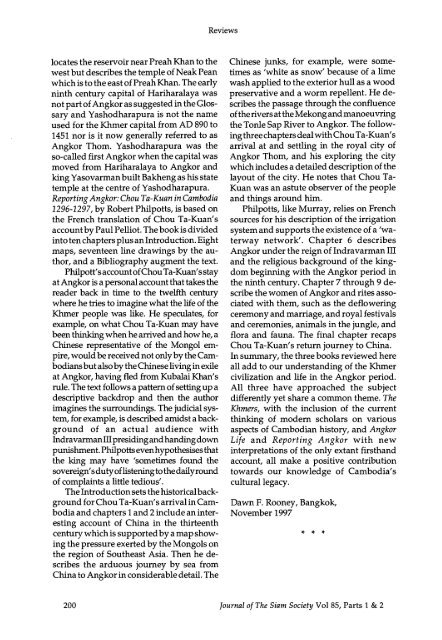The Journal of the Siam Society Vol. LXXXV, Part 1-2, 1997 - Khamkoo
The Journal of the Siam Society Vol. LXXXV, Part 1-2, 1997 - Khamkoo
The Journal of the Siam Society Vol. LXXXV, Part 1-2, 1997 - Khamkoo
Create successful ePaper yourself
Turn your PDF publications into a flip-book with our unique Google optimized e-Paper software.
Reviews<br />
locates <strong>the</strong> reservoir near Preah Khan to <strong>the</strong><br />
west but describes <strong>the</strong> temple <strong>of</strong> N eak Pean<br />
which is to <strong>the</strong> east <strong>of</strong> Preah Khan. <strong>The</strong> early<br />
ninth century capital <strong>of</strong> Hariharalaya was<br />
not part <strong>of</strong> Angkor as suggested in <strong>the</strong> Glossary<br />
and Yashodharapura is not <strong>the</strong> name<br />
used for <strong>the</strong> Khmer capital from AD 890 to<br />
1451 nor is it now generally referred to as<br />
Angkor Thorn. Yashodharapura was <strong>the</strong><br />
so-called first Angkor when <strong>the</strong> capital was<br />
moved from Hariharalaya to Angkor and<br />
king Yasovarman built Bakheng as his state<br />
temple at <strong>the</strong> centre <strong>of</strong>Yashodharapura.<br />
Reporting Angkor: Chou Ta-Kuan in Cambodia<br />
1296-1297, by Robert Philpotts, is based on<br />
<strong>the</strong> French translation <strong>of</strong> Chou Ta-Kuan's<br />
account by Paul Pelliot. <strong>The</strong> book is divided<br />
into ten chapters plus an Introduction. Eight<br />
maps, seventeen line drawings by <strong>the</strong> author,<br />
and a Bibliography augment <strong>the</strong> text.<br />
Philpott'saccount<strong>of</strong>ChouTa-Kuan'sstay<br />
at Angkor is a personal account that takes <strong>the</strong><br />
reader back in time to <strong>the</strong> twelfth century<br />
where he tries to imagine what <strong>the</strong> life <strong>of</strong> <strong>the</strong><br />
Khmer people was like. He speculates, for<br />
example, on what Chou Ta-Kuan may have<br />
been thinking when he arrived and how he, a<br />
Chinese representative <strong>of</strong> <strong>the</strong> Mongol empire,<br />
would be received not only by <strong>the</strong> Cambodians<br />
but also by <strong>the</strong> Chinese living in exile<br />
at Angkor, having fled from Kubalai Khan's<br />
rule. <strong>The</strong> text follows a pattern <strong>of</strong> setting up a<br />
descriptive backdrop and <strong>the</strong>n <strong>the</strong> author<br />
imagines <strong>the</strong> surroundings. <strong>The</strong> judicial system,<br />
for example, is described amidst a background<br />
<strong>of</strong> an actual audience with<br />
lndravarmanill presiding and handing down<br />
punishment. Phil potts even hypo<strong>the</strong>sises that<br />
<strong>the</strong> king may have 'sometimes found <strong>the</strong><br />
sovereign' sduty <strong>of</strong>listeningto<strong>the</strong>dailyround<br />
<strong>of</strong> complaints a little tedious'.<br />
<strong>The</strong> Introduction sets <strong>the</strong> historical background<br />
for Chou Ta-Kuan' s arrival in Cambodia<br />
and chapters 1 and 2 include an interesting<br />
account <strong>of</strong> China in <strong>the</strong> thirteenth<br />
century which is supported by a map showing<br />
<strong>the</strong> pressure exerted by <strong>the</strong> Mongols on<br />
<strong>the</strong> region <strong>of</strong> Sou<strong>the</strong>ast Asia. <strong>The</strong>n he describes<br />
<strong>the</strong> arduous journey by sea from<br />
China to Angkor in considerable detail. <strong>The</strong><br />
Chinese junks, for example, were sometimes<br />
as 'white as snow' because <strong>of</strong> a lime<br />
wash applied to <strong>the</strong> exterior hull as a wood<br />
preservative and a worm repellent. He describes<br />
<strong>the</strong> passage through <strong>the</strong> confluence<br />
<strong>of</strong><strong>the</strong> rivers at <strong>the</strong> Mekong and manoeuvring<br />
<strong>the</strong> Tonie Sap River to Angkor. <strong>The</strong> following<br />
three chapters deal with Chou Ta-Kuan' s<br />
arrival at and settling in <strong>the</strong> royal city <strong>of</strong><br />
Angkor Thorn, and his exploring <strong>the</strong> city<br />
which includes a detailed description <strong>of</strong> <strong>the</strong><br />
layout <strong>of</strong> <strong>the</strong> city. He notes that Chou Ta<br />
Kuan was an astute observer <strong>of</strong> <strong>the</strong> people<br />
and things around him.<br />
Philpotts, like Murray, relies on French<br />
sources for his description <strong>of</strong> <strong>the</strong> irrigation<br />
system and supports <strong>the</strong> existence <strong>of</strong> a 'waterway<br />
network'. Chapter 6 describes<br />
Angkor under <strong>the</strong> reign <strong>of</strong> Indravarman III<br />
and <strong>the</strong> religious background <strong>of</strong> <strong>the</strong> kingdom<br />
beginning with <strong>the</strong> Angkor period in<br />
<strong>the</strong> ninth century. Chapter 7 through 9 describe<br />
<strong>the</strong> women <strong>of</strong> Angkor and rites associated<br />
with <strong>the</strong>m, such as <strong>the</strong> deflowering<br />
ceremony and marriage, and royal festivals<br />
and ceremonies, animals in <strong>the</strong> jungle, and<br />
flora and fauna. <strong>The</strong> final chapter recaps<br />
Chou Ta-Kuan's return journey to China.<br />
In summary, <strong>the</strong> three books reviewed here<br />
all add to our understanding <strong>of</strong> <strong>the</strong> Khmer<br />
civilization and life in <strong>the</strong> Angkor period.<br />
All three have approached <strong>the</strong> subject<br />
differently yet share a common <strong>the</strong>me. <strong>The</strong><br />
Khmers, with <strong>the</strong> inclusion <strong>of</strong> <strong>the</strong> current<br />
thinking <strong>of</strong> modem scholars on various<br />
aspects <strong>of</strong> Cambodian history, and Angkor<br />
Life and Reporting Angkor with new<br />
interpretations <strong>of</strong> <strong>the</strong> only extant firsthand<br />
account, all make a positive contribution<br />
towards our knowledge <strong>of</strong> Cambodia's<br />
cultural legacy.<br />
Dawn F. Rooney, Bangkok,<br />
November <strong>1997</strong><br />
* * *<br />
200<br />
<strong>Journal</strong> <strong>of</strong> <strong>The</strong> <strong>Siam</strong> <strong>Society</strong> <strong>Vol</strong>85, <strong>Part</strong>s 1 & 2

















